Absinthe, the green fairy. A mysterious drink that has captivated imaginations for centuries. But what exactly is it? Absinthe is a strong spirit made from herbs, with anise, fennel and wormwood as the main ingredients. The latter, a bitter plant, gives absinthe its unique flavour and its nickname “green fairy”. The drink gets its colour from chlorophyll in the herbs. No artificial colouring, just pure nature.
In this blog ...
- History of absinthe
- How is absinthe made?
- The popularity of absinthe
- Absinthe advertising: Seduction in colour
- Absinthism: The spectre of the green fairy
- Illegal distilleries and the comeback
- The absinthe ritual: Magic in a glass
- The Jura: Perfect region for absinthe
- Walking the Route d’Absinthe
- You may also be interested in…
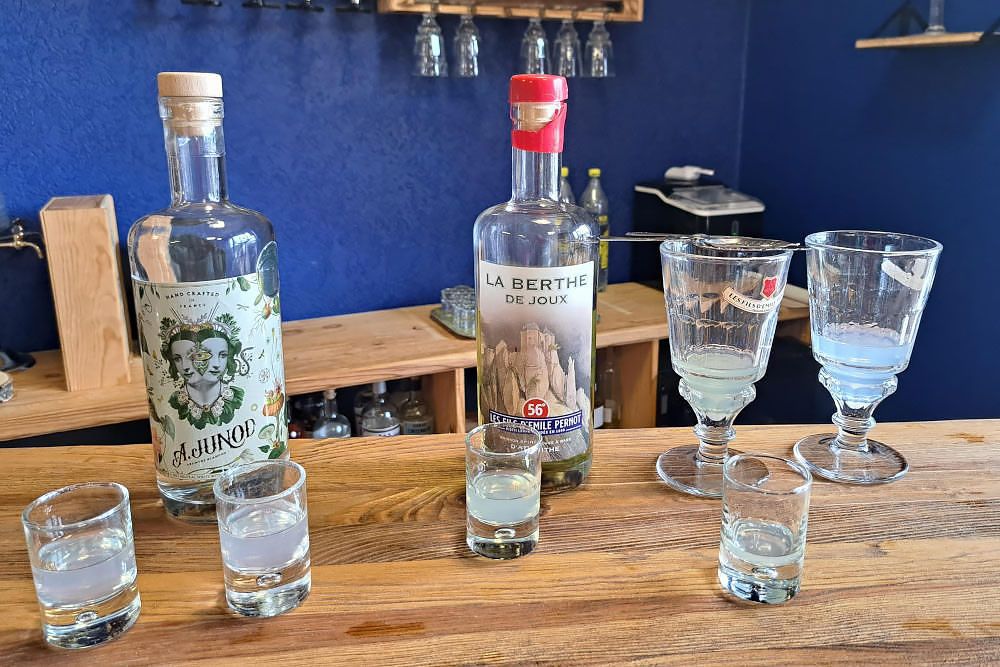
History of absinthe
Absinthe was initially a medicine. The story goes that the recipe was developed by a French doctor who lived in the Swiss Jura in 1792. He used wormwood, anise and other herbs to make an elixir that he considered a remedy for various ailments. This drink found its way to the Henriod sisters, who passed the recipe on to their neighbour, Henri-Louis Pernod.
Pernod saw the potential of the drink and started the first commercial absinthe distillery in Couvet, in the Swiss Val de Travers, in 1797. Later, in 1805, he opened a second distillery in Pontarlier, just across the border in France. The recipe and preparation method remained the same, but demand increased. Absinthe became popular as an aperitif and tonic, and not long after, it became the favourite drink of artists and intellectuals in Paris.
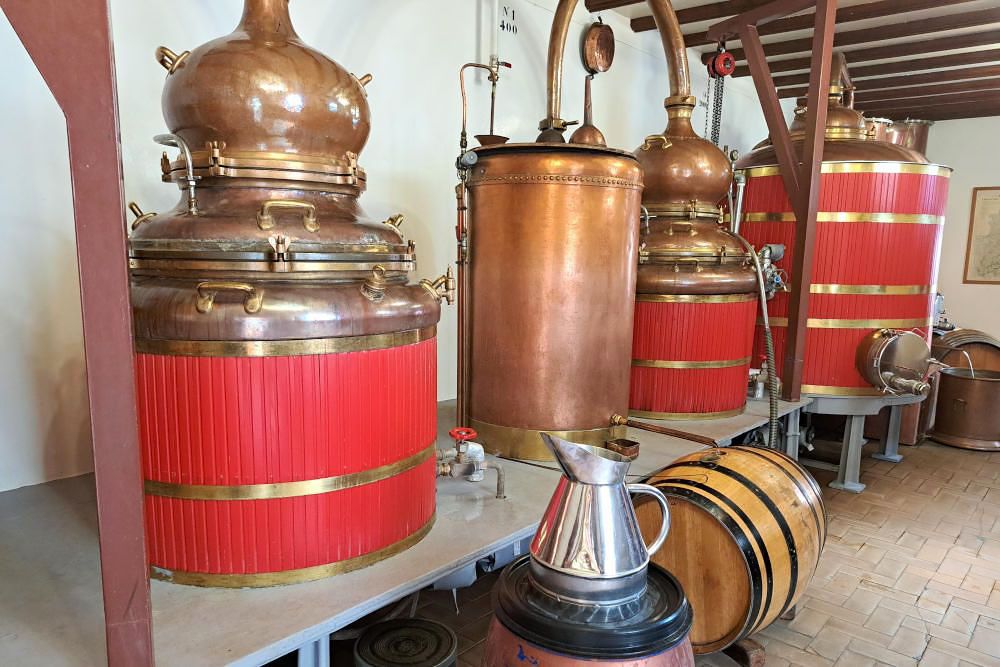
How is absinthe made?
The process begins with steeping wormwood, anise, fennel and other herbs in alcohol. Then the mixture is distilled, just like gin or whisky. Afterwards, it’s mixed with herbs again for flavour and colour. The result? A strong, spicy drink with an alcohol percentage sometimes as high as 70%! But don’t panic – you never drink it neat. You dilute it with water and sometimes a bit of sugar, which creates that beautiful, milky haze in your glass.
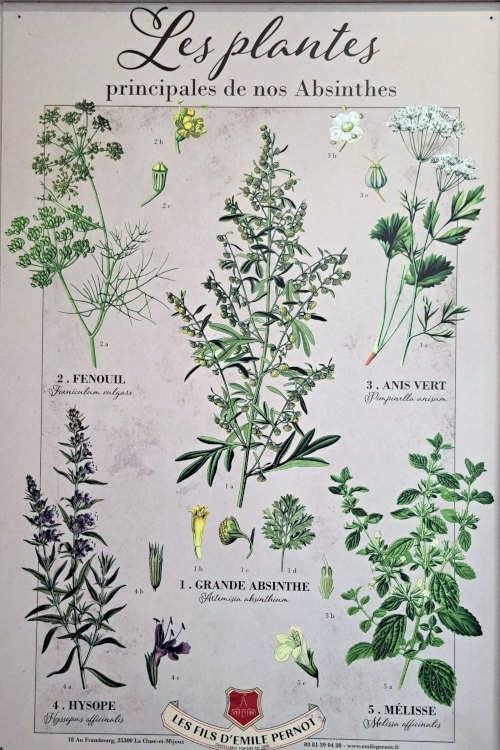
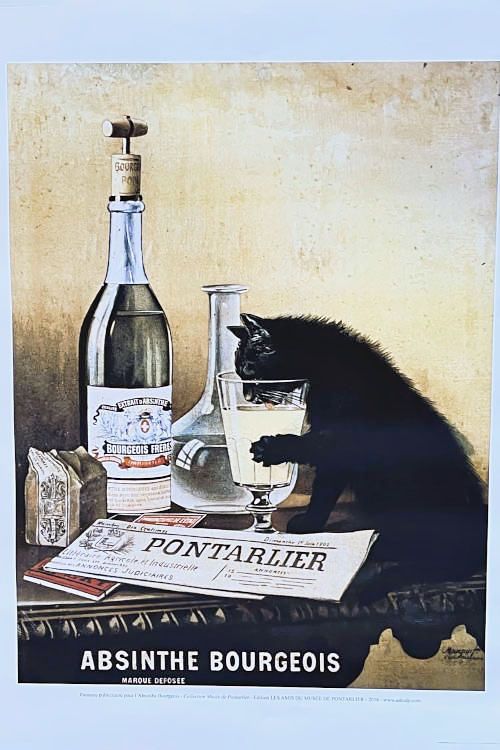
The popularity of absinthe
In the 19th century, absinthe was THE drink of artists, writers and adventurers. People like Vincent van Gogh, Oscar Wilde and Ernest Hemingway swore by their daily glass of absinthe. It was drunk in the cafés of Paris, during poetry evenings and in art galleries. Why? It was said to stimulate creativity, open your mind. And of course, it gave quite a kick due to its high alcohol content.
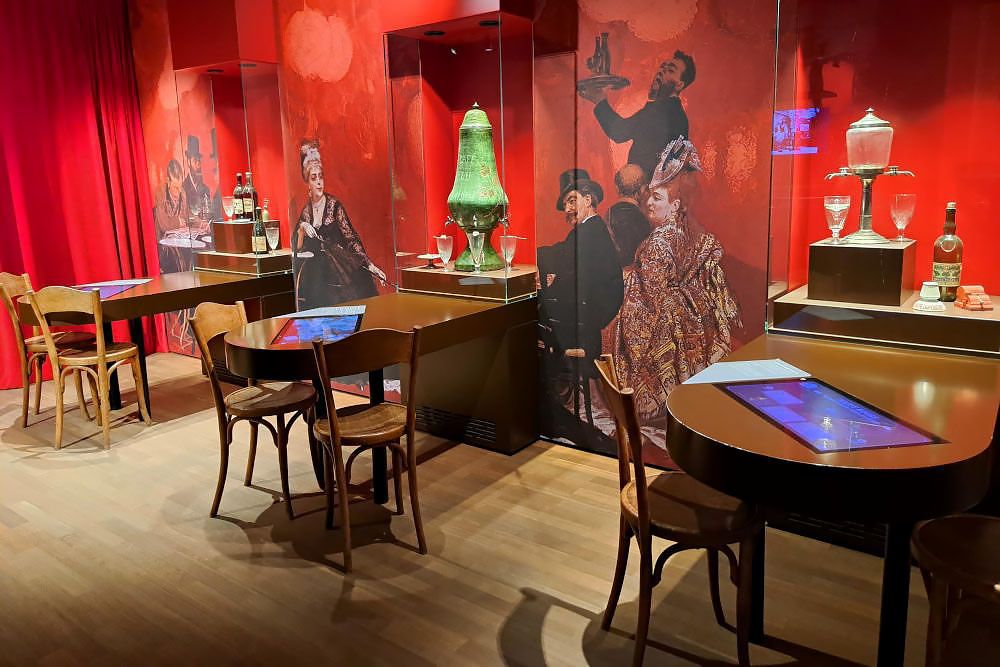
Absinthe advertising: Seduction in colour
Absinthe was not just a drink; it was also a cultural phenomenon. This is reflected in the beautiful posters that were made in the late 19th and early 20th centuries to promote absinthe. These posters were real works of art, often in the Art Nouveau style. This style is characterised by graceful lines, sweeping patterns and an organic, almost dreamy appearance.
The posters were meant to convey the mystique and allure of absinthe. They often depicted fairy-like women – the green fairy herself – with long, flowing hair, surrounded by flowers and plants. Sometimes they held up a glass of absinthe, in which the light of the world seemed to be reflected. Famous artists such as Alphonse Mucha and Henri Privat-Livemont made these posters, which are still considered iconic and collectible today.
The bright colours and striking designs caught the attention of passers-by and emphasised the vibrant, creative energy associated with absinthe. They played a major role in creating the almost mythical status of the green fairy. The posters were not just advertisements; they were invitations to a world of imagination and adventure – exactly as absinthe was intended.
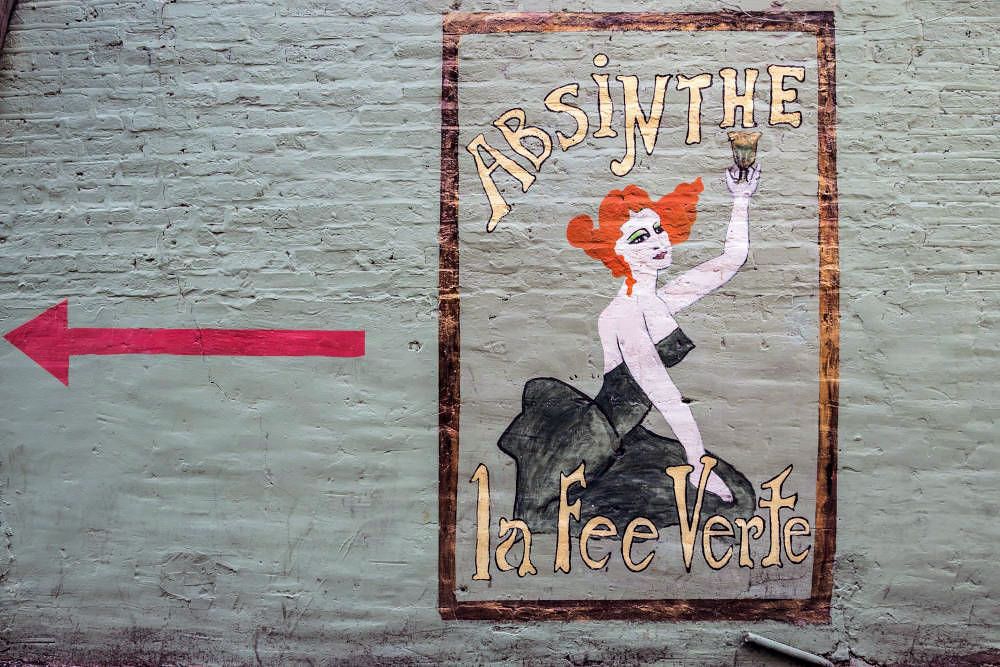
Absinthism: The spectre of the green fairy
“Absinthism” was a term that emerged in the 19th and early 20th centuries, as absinthe became increasingly popular. It was used to describe a range of symptoms supposedly caused by excessive use of absinthe. People believed that drinking absinthe not only led to ordinary drunkenness, but also to more serious complaints such as hallucinations, epileptic seizures, madness, and even death. Absinthism was seen as a unique, dangerous phenomenon – different from alcoholism.
This fear was fuelled by various incidents, such as the infamous “absinthe murder” of 1905 in Switzerland, where a man murdered his family after drinking absinthe. Such incidents caused moral panic and led to campaigns to ban absinthe. Scientists and doctors of the time claimed that thujone, a substance in wormwood, was responsible for the mentioned symptoms. They believed that thujone could affect the brain and thus lead to absinthism.
However, later research showed that these claims were largely exaggerated or incorrect. The amounts of thujone in absinthe were too low to cause the effects that were then attributed to absinthism. What was then considered “absinthism” was probably mainly the result of excessive alcohol consumption in general. This in a time when people also drank other strong spirits and cheap, chemically contaminated absinthe.
Nevertheless, the term “absinthism” played an important role in the history of the green fairy. It eventually led to bans in many countries. It wasn’t until the late 20th century that absinthe was restored to honour, when it turned out that it had all been a matter of myth and misconception.
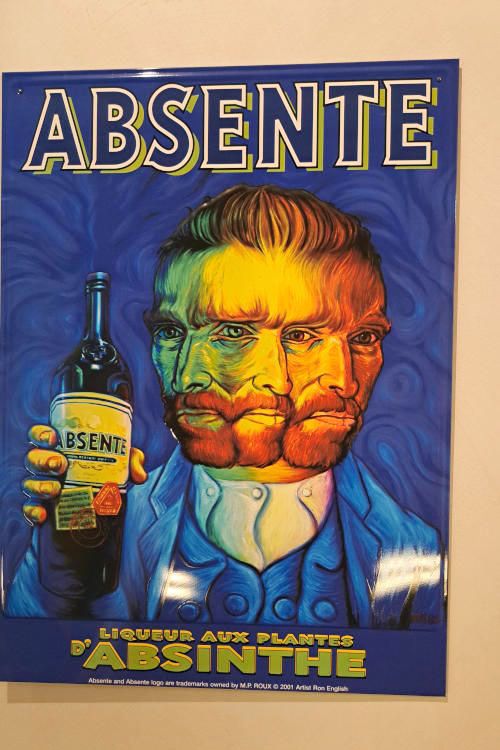
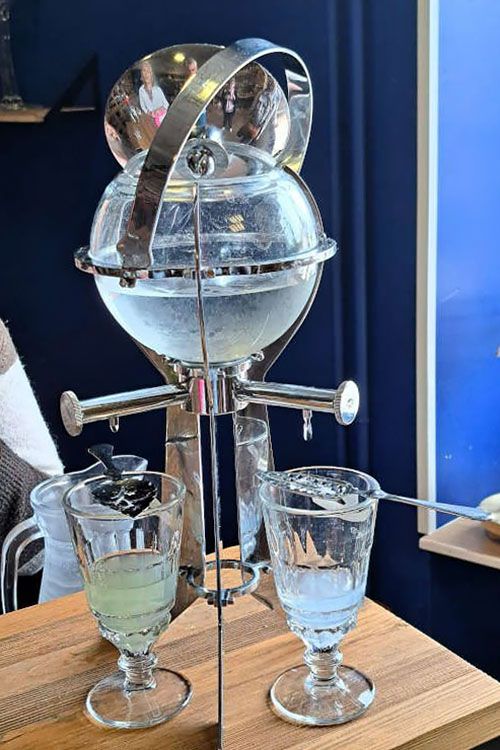
Illegal distilleries and the comeback
Banned? No problem! Absinthe disappeared from sight, but not from the hearts of its lovers. There was plenty of illegal distilling in barns, cellars and remote villages. Especially in the Val de Travers, where absinthe originated. Here the tradition remained alive, secretly and rebelliously.
In the 1990s, the resurrection of absinthe began. Research showed that thujone in absinthe was not dangerous in normal quantities. Slowly but surely, the ban was lifted. Small distilleries resurfaced. The green fairy made her comeback. And now she’s everywhere again: in trendy cocktail bars, at festivals, and even on the “Route d’Absinthe”, the beautiful walking route through the Jura.
Absinthe is back. And just like in the old days, it’s still a drink for dreamers, daredevils and creative spirits. Cheers to the green fairy!
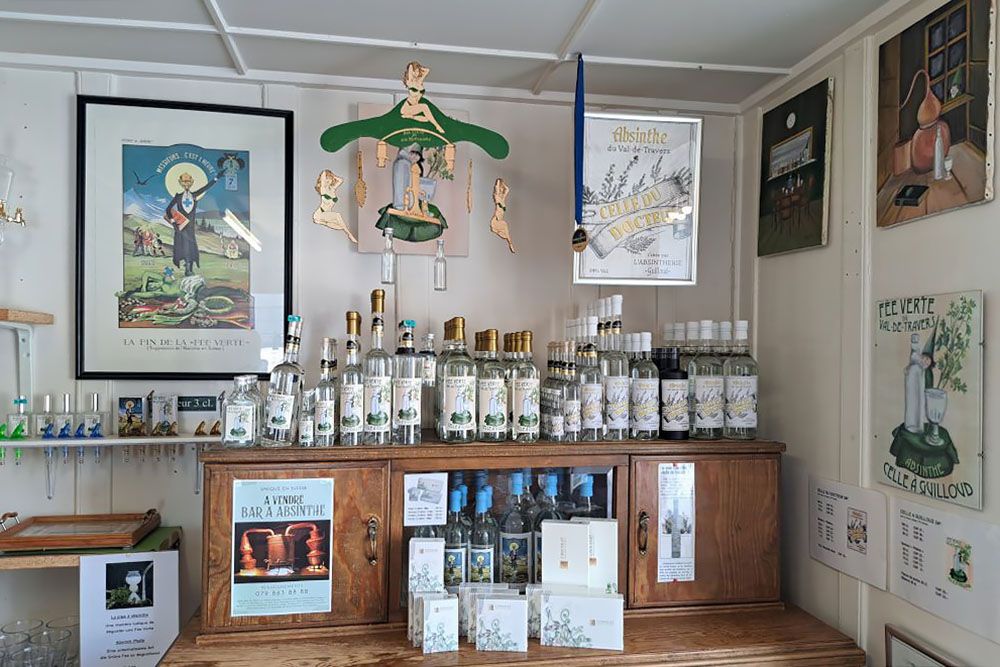
The absinthe ritual: Magic in a glass
Drinking absinthe is not just taking a sip. It’s a ritual. First, you place a special spoon, often beautifully decorated, on the rim of your glass. On the spoon, you place a sugar cube. From an absinthe bottle or fountain, ice-cold water slowly drips over the sugar, which gently melts and drips into the glass. Slowly, the bright green absinthe turns into a cloudy, milky liquid. This is called the “louche”. The water mixes with the drink and creates a new, rich flavour.
But this ritual is more than just a way to prepare your absinthe. It symbolises the mystique of the green fairy – slowly revealed, layer by layer. It’s a moment of patience, of dedication. The artistic spoons used for this are often made of silver or tin, with intricate patterns of flowers, fairies or graceful shapes. Each spoon is unique, just like the drinker. They add a touch of fantasy to the ritual, just as absinthe does for the mind. In short, it’s an ode to beauty, mystery and imagination – exactly what the green fairy promises you.
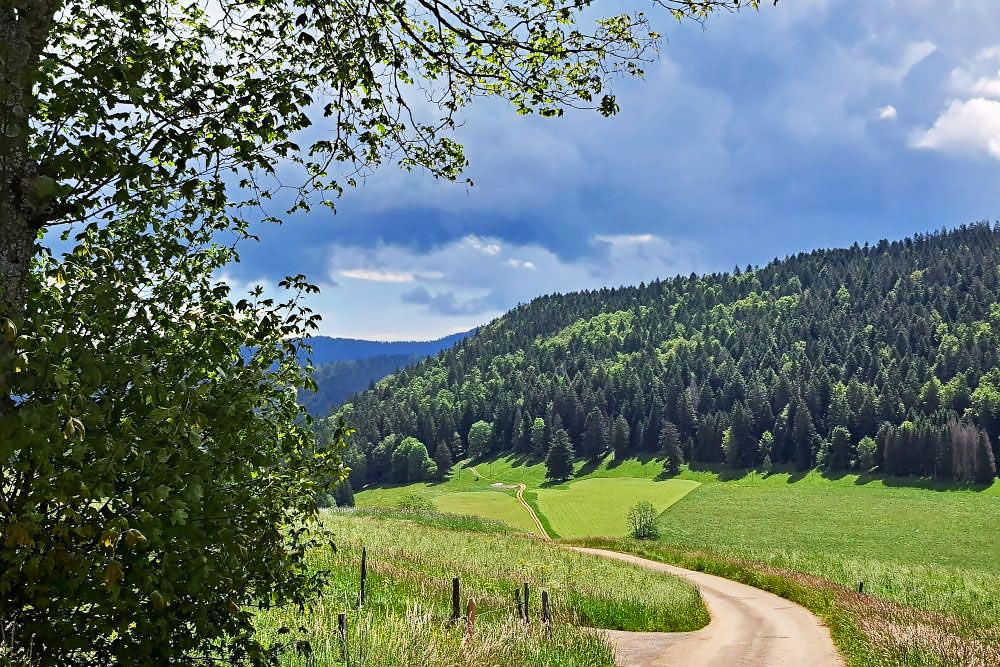
The Jura: Perfect region for absinthe
Why the Jura specifically? The French and Swiss Jura regions are ideal for absinthe production. The mountains, cool climate, and limestone-rich soil provide the perfect conditions for growing the herbs essential to absinthe. Wormwood, in particular, grows abundantly here. The pure spring water from the mountains is also crucial. The water is soft and rich in minerals, contributing to the purity and taste of the absinthe.
Moreover, the Jura regions were remote and sparsely populated, making them perfect places for continuing to produce absinthe illegally during the prohibition period. This region is therefore the birthplace and soul of absinthe – this is where the green fairy came to life and where she always returns.
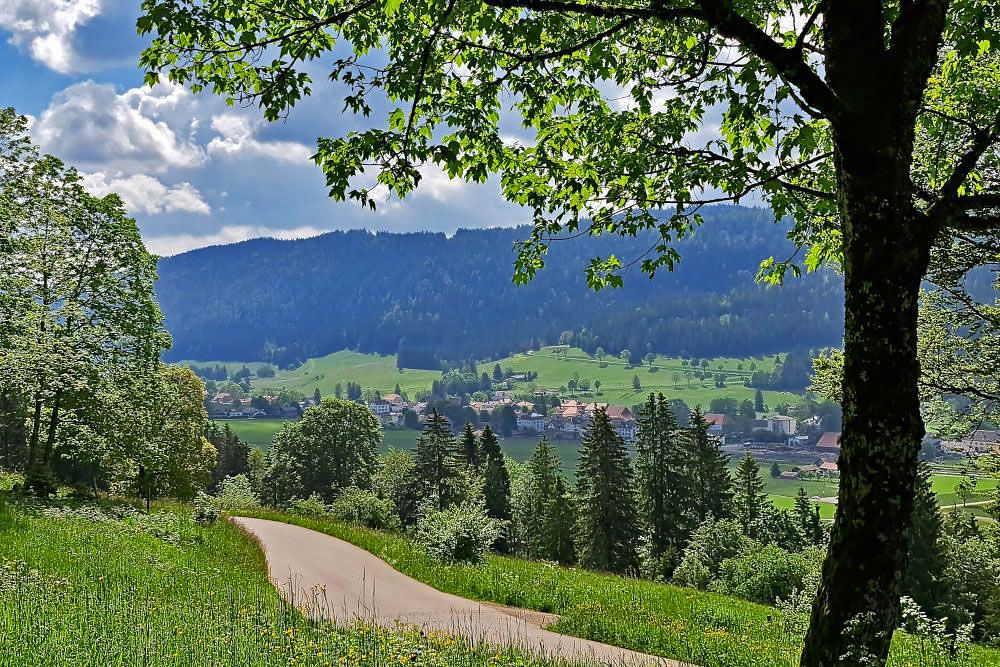
Walking the Route d’Absinthe
A unique 48-kilometre walking route reveals all the secrets of this mythical drink. We walked for three days from Pontarlier in France to Couvet in Switzerland. It became a journey that led us through the heart of the absinthe world. We walked through forests, past fields and old distilleries. Along the way, we visited museums and producers. We had a stunning view of the Jura at every moment. So put on your walking shoes and let the green fairy be your guide on the Route d’Absinthe! In our extensive blog about the Route d’Absinthe, you can read about our experiences and tips.
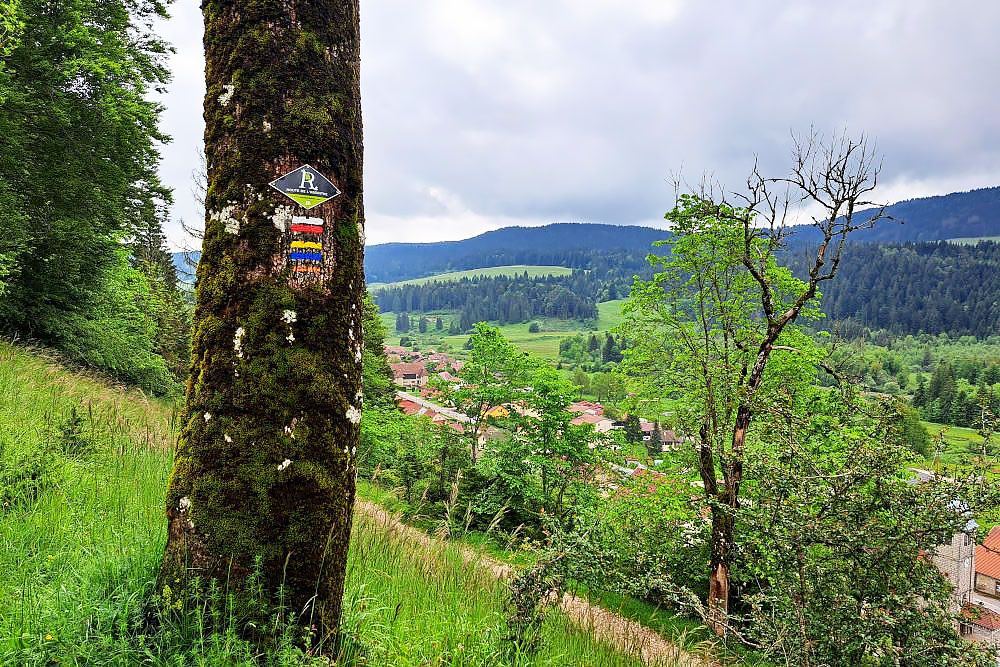
At the invitation of the Bourgogne-Franche-Comté region, Montagnes du Jura and the Bureau du Tourisme Haut-Doubs, we walked the Route d’Absinthe. We have compiled the blog independently and objectively based on our own impressions.
You may also be interested in…
- The Route d’Absinthe: In search of the green fairy
- Hiking in the Jura Mountains, the “pure France”
- Nevers, the Burgundian city of the dukes on the Loire river
- Cycling holiday through Burgundy on the Loire
- Burgundy wine route through the Côte d’Or
- Dijon, the Burgundian capital of mustard
- Highlights of the Morvan nature reserve
- Autun, gateway to the Morvan



